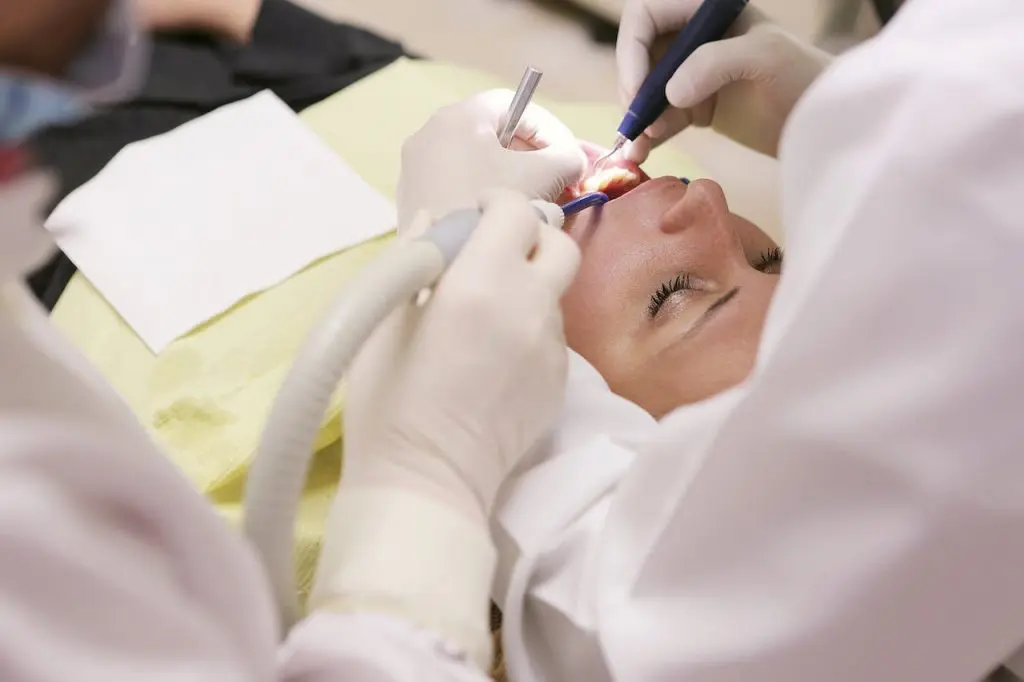Estimated reading time: 4 mins
Teeth whitening’s popularity in cosmetic dentistry stems from its ability to significantly improve the aesthetics of one’s smile. The process, grounded in sophisticated chemical reactions, not only targets surface stains but also alters the intrinsic coloration of teeth. Here, we delve deeper into the foundational science and additional considerations that dictate the success and safety of whitening treatments.

Advanced Chemistry at Play
The bleaching agents—hydrogen peroxide and carbamide peroxide—serve as the cornerstone of teeth whitening. These compounds release oxygen free radicals upon activation, which then penetrate the tooth enamel to reach the dentin layer. The dentin, which significantly influences the tooth’s color, houses chromogens, or color-producing molecules, that absorb and reflect light. The oxygen radicals react with these chromogens, breaking down the complex molecules into smaller, less pigmented components. This reaction not only directly reduces the concentration of discoloration but also alters the optical properties of the tooth, making it appear whiter. Consult a dentist in Stillwater, MN for professional teeth whitening services tailored to your needs.
Technological Enhancements in Whitening Procedures
In pursuit of more efficient and effective whitening outcomes, dental technology has introduced innovations such as light-accelerated bleaching. Devices emitting LED, halogen, or plasma arc light claim to activate the peroxide compound more effectively, speeding up the decomposition process and achieving quicker results. While studies on the efficacy of light-activated whitening show mixed results, these methods have gained popularity for their potential to enhance the whitening experience and reduce treatment time.
Personalized Treatment Approaches
Individual response to teeth whitening varies widely, influenced by factors such as the natural color of the teeth, the type and severity of staining, and the tooth’s structural integrity. Genetic factors determine the baseline color of a person’s teeth, which can range from more yellow to more grey hues, affecting how responsive they are to whitening treatments. Extrinsic stains, typically caused by dietary choices and smoking, tend to respond well to bleaching, whereas intrinsic stains, such as those from medication or fluorosis, may require more aggressive or alternative cosmetic treatments.
Safety Considerations and Patient Comfort
The safety profile of teeth whitening treatments is generally favorable, especially under professional supervision. However, patients may experience temporary side effects such as tooth sensitivity and mild gum irritation. Innovations in product formulation, including the addition of desensitizing agents like potassium nitrate and fluoride, aim to enhance patient comfort. Dentists also customize treatment plans, adjusting the concentration of bleaching agent and duration of exposure to minimize potential discomfort while optimizing whitening outcomes.
Long-term Maintenance and Care
Achieving lasting whitening results extends beyond the initial treatment. Patients are advised to avoid or limit exposure to staining agents, adhere to stringent oral hygiene practices, and consider occasional maintenance treatments. The commitment to preserving the effects of whitening involves a partnership between the dental professional and the patient, emphasizing the importance of follow-up care and lifestyle modifications.
Practical Aspects of Teeth Whitening: Making Informed Choices
With a deeper understanding of how teeth whitening works, patients can navigate their options with greater confidence. This section addresses key considerations for those contemplating teeth whitening, aiming to maximize benefits while minimizing risks.
Choosing the Right Whitening Option
The decision between professional whitening treatments and at-home options in Stillwater, MN, hinges on several factors, including the nature of the tooth discoloration, the desired speed of results, and budget considerations. Professional treatments offer the advantage of immediate, noticeable outcomes and the safety of dentist supervision. At-home kits, while more gradual and less potent, provide a convenient and cost-effective alternative for those with mild staining or budget constraints. For more information on teeth whitening in Stillwater, MN, and to decide which option is right for you, check this link.
Setting Realistic Expectations
It’s crucial for patients to have realistic expectations regarding the extent of whitening achievable and the duration of results. Factors such as the original shade of teeth, the presence of intrinsic stains, and individual lifestyle habits (like smoking or consuming staining foods and beverages) can influence both the effectiveness of whitening treatments and the longevity of results. A thorough consultation with a dental professional can help set appropriate expectations based on individual circumstances.
Post-Treatment Care for Lasting Results
Maintaining the results of teeth whitening requires diligent post-treatment care:
- Dietary Adjustments: Limiting intake of staining agents such as coffee, tea, wine, and tobacco can prolong the whitening effects.
- Oral Hygiene: Regular brushing with a whitening toothpaste, flossing, and using an antiseptic mouthwash can help maintain a bright smile.
- Regular Dental Visits: Professional cleanings and check-ups allow for the removal of surface stains and the monitoring of oral health, potentially extending the life of whitening results.
Touch-Up Treatments
Depending on the whitening method used and individual lifestyle choices, some patients may require touch-up treatments to maintain their desired level of whiteness. Discussing a maintenance plan with a dentist ensures that touch-ups are done safely and effectively, without compromising tooth enamel or overall oral health.
Conclusion: Navigating Teeth Whitening with Confidence
Armed with a comprehensive understanding of the science behind teeth whitening and practical considerations for treatment and care, patients are better equipped to make informed decisions regarding their cosmetic dental options. By choosing the right treatment, setting realistic expectations, and committing to proper post-treatment care, individuals can enjoy the benefits of a brighter smile with confidence and peace of mind.
Check out these similar posts:
- Identifying Candidates for Sedation Dentistry: Who Benefits the Most?
- Achieving Your Ideal Smile with Invisalign: A Comprehensive Guide
- What to Do in a Dental Emergency: Immediate Actions and Tips
- Unlocking the Advantages: The Benefits of Dental Implants
- Unveiling the Benefits of All-on-4 Dental Implants

